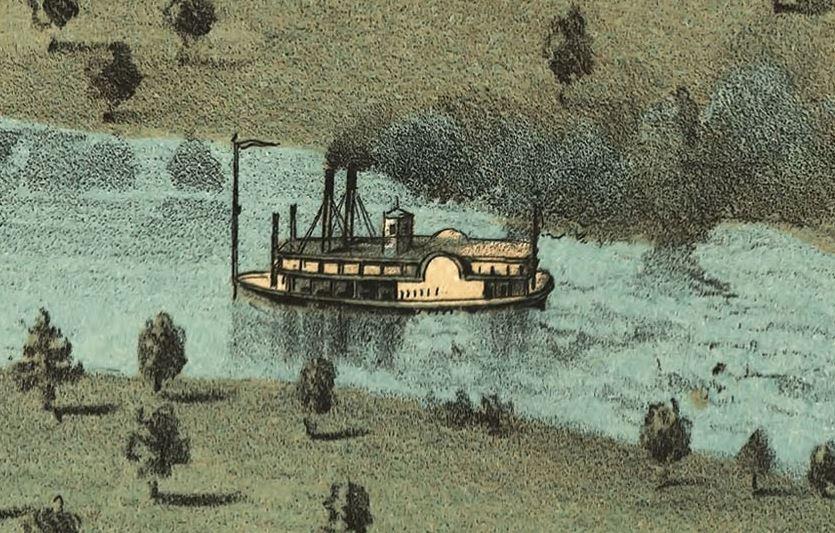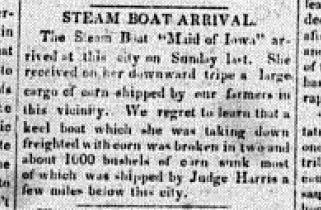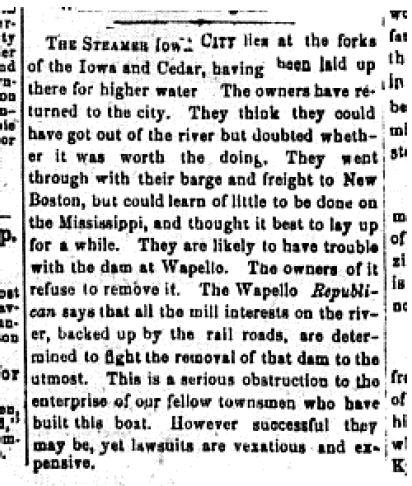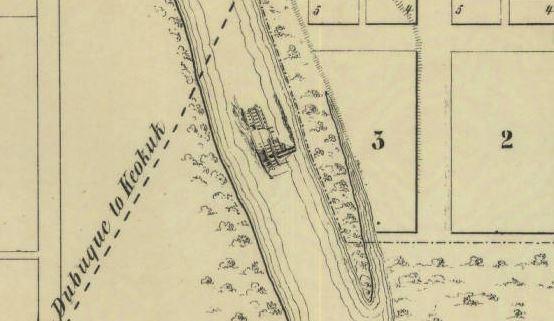Posted by Anne M on Friday, May 18, 2018
While researching the horse racing scene of early Iowa City, my eye moved from the first county fairgrounds to something in the Iowa River—that something being a steamboat. Steamboats in Iowa City in 1868? Didn’t the railroad, reaching Iowa City in 1856 make these boats unnecessary? I always thought that steamboats didn’t make much headway (so many nautical phrases to use) on the Iowa River.
And that is somewhat true.
Before the railroad reached Iowa City, it was a great hope that the Iowa River would support steamboat travel as a way to import and export goods. The hope was written into the City’s code as all bridge construction could not “obstruct navigation.” The first steamer to stop in Iowa City was the Ripple in June of 1841. It arrived unexpected by Iowa Citians, causing much excitement, especially since the Iowa River’s depth wasn’t measured for steamboat travel. A dinner was held to celebrate its arrival with Chauncey Swan, proprietor of the hotel in charge of the festivities. In his speech, Captain Jones of the Ripple remarked that steamboats will bring wealth and prosperity to Iowa City: “From this day henceforth a new era will commence in the destinies of your city.” For more of his speech, the April 1921 edition of “The Palimpsest” includes as much as was noted at the time, originally published in “The Iowa City Standard.”
On the arrival of the Rock River in April 21, 1842, the editor of the “Old Capital Reporter” stated, “Nothing could have exceeded the magnificent scene displayed before us. The steamer moving up in a majestic manner, with the stars and stripes from her bows floating joyously in the breeze, smiling on the luxurious landscape of surpassing beauty and richness, seemed to be greeted by nature’s loveliness in a region which had witnessed for the first time the emblem of the country’s glory.” Some townspeople took the opportunity to ride the Rock River up to the quarry, spending the day strolling and picnicking, making it back to the city by nightfall. The editor went on to say, “That the Iowa is navigable for steamboats of a medium draught for many miles can no longer be doubted.”
After 1841, steamboats intermediately made their way up the Iowa River, mostly for trading corn, pork, wheat, and other commodities. In June 1844, after loading the Maid of Iowa with corn, the crew agreed to tug a large keel boat owned by Judge Harris. It broke apart, dumping one thousand bushels into the river. But the Maid of Iowa returned in September of 1844 prompting the “Old Capital Reporter” to state that there was no doubt Iowa City would prosper now that it has its own port.
In 1845, Charles A. Robbins of Iowa City launched their own steamboat at the boat yards, offering shares in their steamboat company to residents for $25.00. It was the first of several steamboats under construction in Iowa City, perhaps as a response to the irregularity of steamboats coming from the Mississippi river towns. He took the boat to St. Louis and it never returned.
Another attempt was the Iowa City, launched in 1866. It was built by Captain W. Reninger, Col. Harvey Harvey Graham, and Henry Sporleder. It was one hundred and ten feet long. Its first voyage was to New Boston, Illinois and Burlington. The operators of the Iowa City were optimistic, promising weekly trips from Iowa City to the Mississippi River. The depth of the Iowa River proved impassible and the Iowa City spent most of its time on the lower Iowa River and the more profitable Mississippi, headquartering at Wapello. The “Iowa City Republican“ actively updated its readers about where the boat was with hopes that it would return to Iowa City as soon as possible. In an incident in July 1866 (reported 8/1/1866), the boat is stranded near Wapello due to high water and is abandoned by the owners.
Perhaps this is the incident mentioned by the riverboat pilot, Captain E. H. Thomas, (or did this just happen a lot for the Iowa City?). He was asked to free the Iowa City when it ran aground near Fredonia and also mentions the owners left the boat. He recounted this incident as well as his time working on steamboats to the “Burlington Saturday Evening Post,” a series that ran in the paper in 1911 and 1912. It took him a week to get the steamer free and in safer waters. He was hired to run the boat for three seasons. According to Charles Aurner’s “Leading Events in Johnson County,” flames engulfed the steamboat, destroying the Iowa City. However, he says this happened later in the year of 1866. I was unable to find this in the “Iowa City Republican” and Thomas makes no mention of a fire or why he stopped working on the Iowa City. According to the “Iowa Historical Record,” the boat’s fate is far less dramatic. It was sold to new owners in Davenport.
With that, and the railroad being a more efficient way to travel and move goods, the dreams of a “Port of Iowa City” went up in smoke or sold down the river, depending on what metaphor rings true.
Regardless of how the future turned out, from now on I will think of the steamboat in the 1868 Bird’s Eye View of Iowa City as the Iowa City.
Sources
“Arrival of a steamboat.” (1842, Apr. 23). Old Capital Reporter. Retrieved via microfilm from the Iowa City Public Library. PDF version:
Aurner, Charles Ray. Leading Events in Johnson County. Cedar Rapids: Western Historical Press, 1912.
Hibbs, Bob. “Saturday Postcard 198: Steamboating at Iowa City.” Johnson County IAGenWeb Project. Posted June 14, 2003, revised Sept. 23, 2010. Accessed 18 May 2018: http://iagenweb.org/johnson/PostcardHibbs/Postcard16.htm
“The Iowa City.” (1866, Oct. 17). Iowa City Republican. Retrieved via microfilm from the Iowa City Public Library. PDF version:
Lathrop, H. W. “Early steamboating on the Iowa River.” Iowa Historical Record. Iowa City: State Historical Society, 1899.
Parish, John C. “The Ripple.” The Palimpsest. v. II, no. 4 (April 1921). Reprinted on Iowa History: an IAGenWeb Special Project. Accessed 18 May 2018: http://iagenweb.org/history/palimpsest/1921-Apr2.htm
“Steam boat arrival.” (1844, June 8). Old Capital Reporter. Retrieved via microfilm from the Iowa City Public Library. PDF version:
“The Steamer Iowa City.” (1866, July 4). Iowa City Republican. Retrieved via microfilm from the Iowa City Public Library. PDF version:
“The Steamer Iowa City.” (1866, Aug. 1). Iowa City Republican. Retrieved via microfilm from the Iowa City Public Library. PDF version:
Thomas, E. H. “Hard aground in Iowa River.” Burlington Saturday Evening Post, 1911-1912. Reprinted on Iowa History Project. Accessed 18 May 2018: http://iagenweb.org/history/burlingtonpost/chpt44.htm








Add new comment